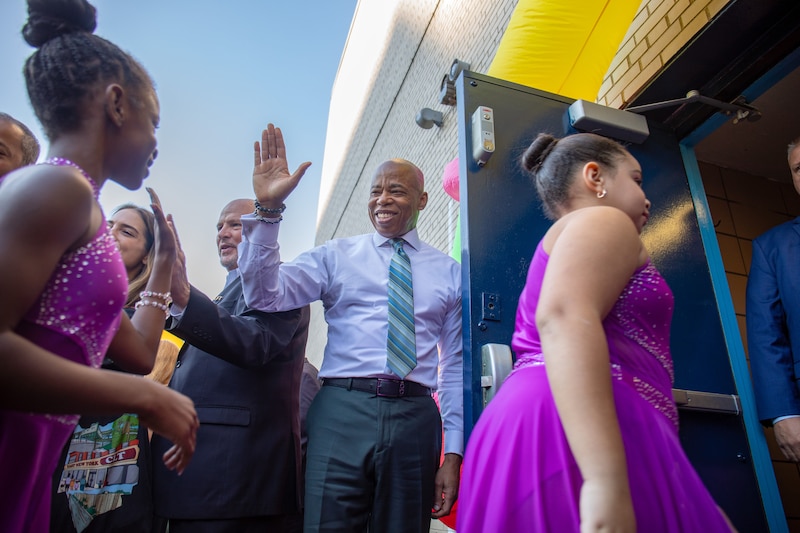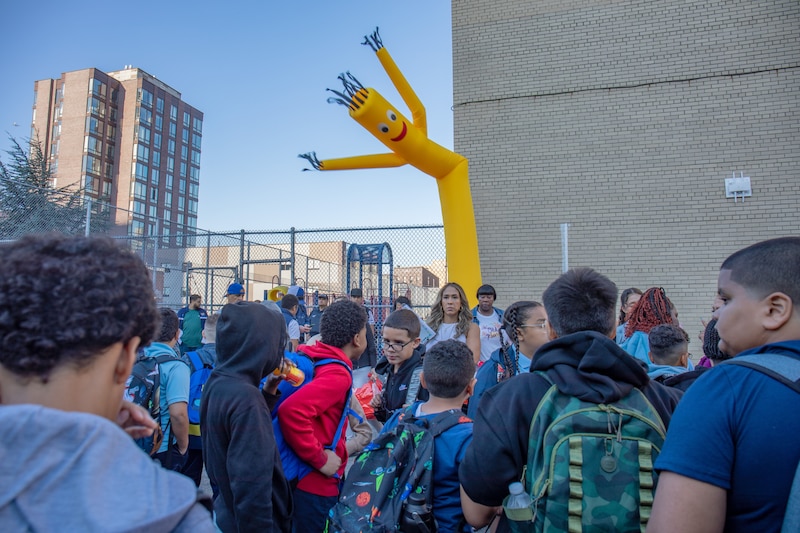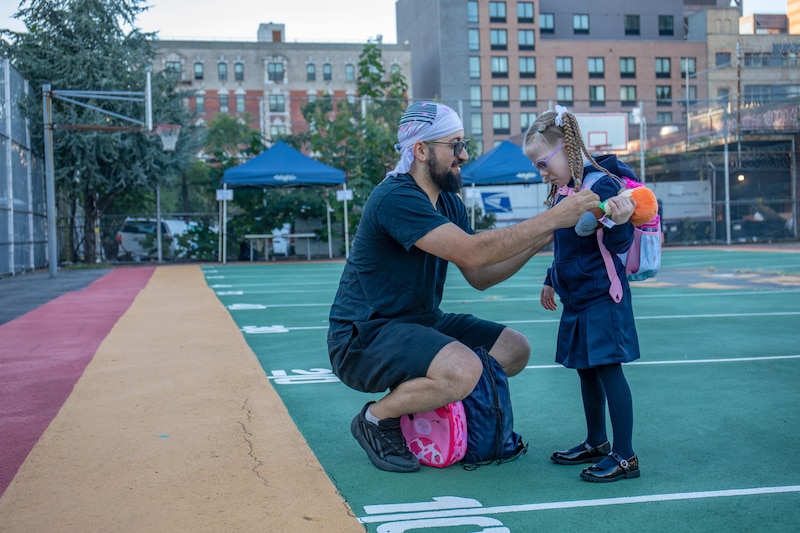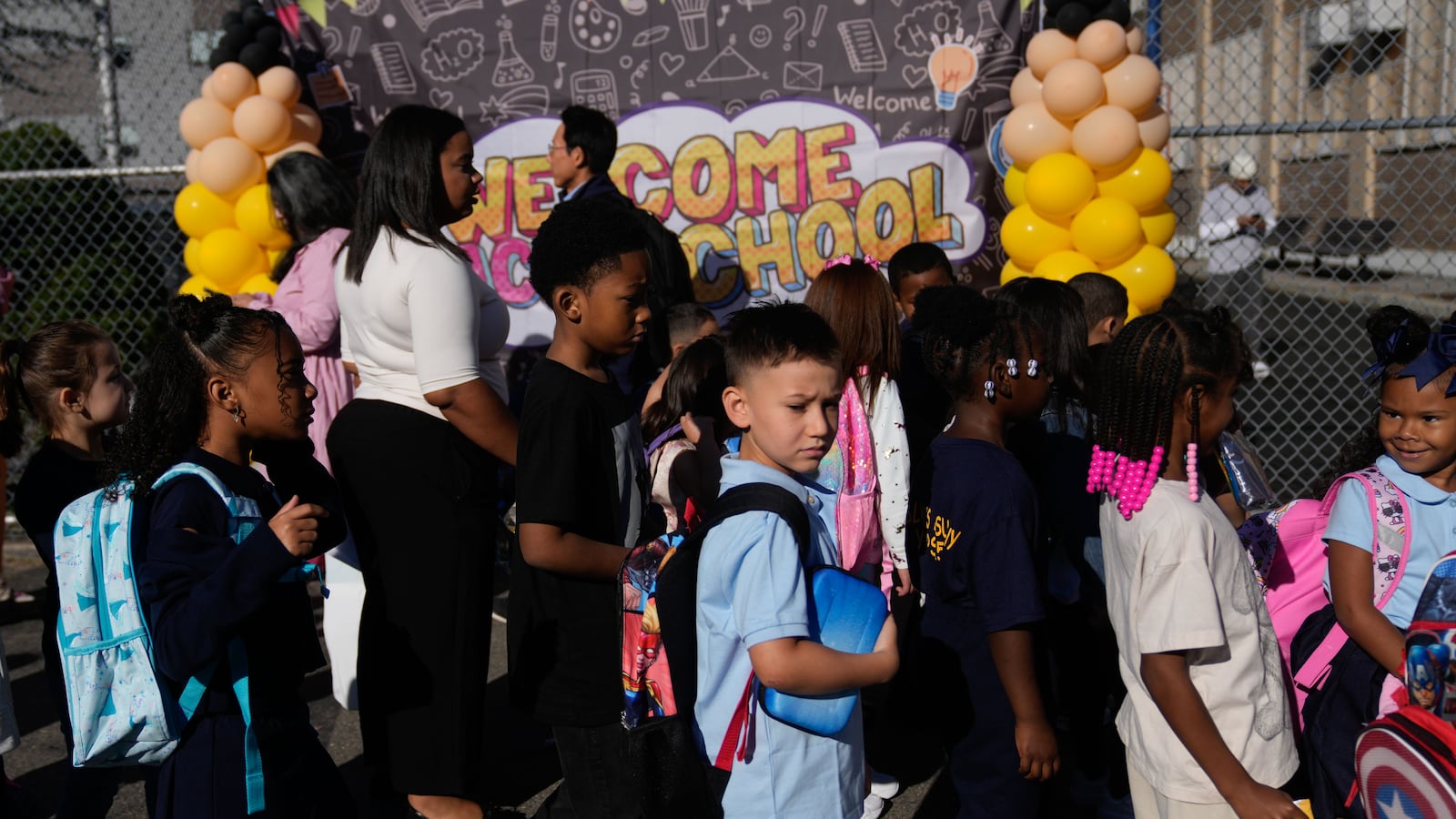Sign up for Chalkbeat New York’s free daily newsletter to keep up with NYC’s public schools.
Bedtimes restored. Alarms reset. Roughly 900,000 public school students returned to New York City’s buses, subways, and blocks on Thursday morning buzzing with nerves and excitement for the first day of school.
Nowhere was the back-to-school energy more amplified than at P.S. 257, a magnet school for the performing arts in Williamsburg, Brooklyn, where Mayor Eric Adams and schools Chancellor David Banks were greeted by a DJ blaring music in a courtyard brimming with families. A smiling inflatable tube man flapped around in the crisp fall weather.
The festivities included a book giveaway and a celebration of the school’s ballet team, who won back-to-back national championships. Kids posed for pictures in front of a welcome back banner, hugging their caregivers before heading inside.
Angelica Jean-Lewis, a 5-year-old entering first grade, could hardly contain her joy, breaking into a dance moments after walking through the school’s front gates. Mary Paul, her mother, said Angelica woke her at 6:30 a.m.
“She was ready to go!” Paul said, laughing.
Banks, who high-fived kids amid the festivities, said, “This is the first day of school. It represents the rebirth of our school system, and we are always excited.”
Still the nation’s largest school system, with roughly 1,600 schools, continues to face challenges.

Enrollment has declined over recent years, but the number of students citywide is expected to hold steady this year, largely due to the thousands of asylum-seeking and other migrant students who have brought their own set of challenges to school. Distractions from cellphones will likely continue to eat up class time, as the city’s put the brakes on a promised citywide cellphone ban. (Though many schools are implementing their own bans, collecting phones or requiring kids to lock them in pouches all day.)
How schools and students use, and perhaps misuse, AI will likely be front and center. Politics will surely touch schools in significant ways once again, with November’s presidential election and continued tensions over the Israel-Hamas war. And neighborhood violence will continue to reach into schools; this week, a teacher had his hand grazed by a stray bullet fired from outside the building, while he was setting up his classroom in the Bronx.
The biggest shift for the 2024-25 school year — and the Adams administration’s signature initiative — will be the continued push to standardize English and math curriculums for many students across the five boroughs. All elementary schools must now use one of three pre-approved reading programs. The city is expanding its ninth grade algebra curriculum mandate for nearly all schools and is scaling up a middle school math mandate over the next three years. The city has also required a curriculum for prekindergarten.
Few parents at P.S. 257, where Adams and Banks mingled with families, knew anything about the reading curriculum changes. Their school, in District 14, will be using a program called Into Reading, which is by far the most popular of the three curriculums. All elementary schools in 22 of the city’s 32 local school districts are using it this year.
Roseleen Magdaleno, a fourth grader at the school, said reading was her favorite subject in school — though her family wasn’t aware that the city’s literacy curriculum had changed in recent years.
Andrea Cole, whose sons Zyon and Trystan attend fifth and third grade respectively at P.S. 257, wasn’t aware of the city’s literacy curriculum overhaul. But she said she felt good about the instruction her sons were receiving, even though the material could be difficult.
“I feel like the curriculum that they’re teaching is a bit challenging for some students,” she said. “But anything new to children, they’re going to automatically grasp later on.”
It is perhaps unsurprising that parents weren’t aware of the changes. Some parents have complained that they feel in the dark about their school’s reading programs and are hungry for more communication.
At P.S. 138 in Crown Heights, Brooklyn, in District 17, which is adopting Into Reading this year, none of the parents Chalkbeat spoke with had heard about the city’s literacy initiative.
King, a third grader with a bright blue Sonic the Hedgehog backpack, was ready to start his first day at the school after transferring from a charter school. His dad, who declined to give his name, said he was most nervous about the state tests that begin in third grade. He hadn’t heard about the city’s new reading curriculum initiative, but he welcomed the focus on literacy.
“Reading comprehension is where he really needs more work on,” King’s dad said.
Just under half of New York City students in grades 3-8 are considered proficient in English, based on state exam scores, which was a big impetus for the curriculum shift.
After nearly half of the city’s school districts joined the new curriculum mandate last year (with the rest starting this year), scores on state English exams dropped — even more steeply for the schools already using the mandated curriculums, a Chalkbeat analysis found. Experts, however, urged caution when interpreting aggregate test scores since other variables could push scores up or down, such as fluctuations in federal COVID relief funding and elevated rates of chronic absenteeism.
Kids were more focused on things like school lunch — and last year, students mobilized when the city cut some of its most popular food items. Olivia Rivera, a P.S. 257 third grader, was most looking forward to a return to the cafeteria.
“My favorite is yogurt,” she said.
Olivia, who is on the autism spectrum, has attended the school since pre-K. Her mother, Awilda Rivera, said the school has been transformative for her daughter.
“In the beginning, she was a little shy,” said Rivera, who is also a member of the school’s PTA. “But with all the support, she’s been singing here.”

Middle and high school admissions season already underway
Eddie Espada, a paraprofessional at P.S. 257, said both he and his fifth-grade son Jordan were thrilled to start the school year.
“He’s a little nervous about it as well, because it’s his last year,” Espada said.
They’re already preparing for the middle school admissions process this fall, hoping to stay close to home in Bushwick, just a few blocks from their elementary school.
For the city’s families of fifth and eighth graders, the clock starts ticking for middle and high school applications almost as soon as the year starts. High school applications open Oct. 1 and close Dec. 4, according to the Education Department. Middle school applications open Oct. 9 and close Dec. 13. (Offers are sent out March 6 and April 9, respectively.)
Tatiana Cruz just went through the kindergarten admissions process for her daughter’s first year at P.S. 138 in Crown Heights, Brooklyn. After having her daughter in the preschool where she works, Cruz felt some anxiety as she dropped her off in a sea of students in red and burgundy uniforms, awaiting a classroom assignment from a school staffer with a clipboard. But Cruz was no stranger to the school.
“I went here,” Cruz said. “That’s why I wanted her to come here.”
Cruz appreciated that school still gives kids opportunities to work with paper and pencil and practice handwriting, even as schools increasingly move towards laptops and tablets.

Ongoing debate over cellphone ban
As more school districts across the nation have embraced cellphone bans this year, New York City is continuing to take its time despite initially promising otherwise.
Kevin Alvarez, a 12th grader at the Williamsburg High School of Art and Technology, said his school doesn’t have a cellphone ban in place, though teachers ask them not to use them during class.
Though phones can be distracting, Alvarez said he doesn’t believe a citywide ban on phones in schools is needed.
“If people know how to control themselves, I don’t think it’s a problem,” he said. “Me and my friends, we don’t really have that problem.”
Marielis Acosta, another 12th grader at the school, noted phones can come in handy during the school day — allowing them to quickly calculate equations or translate between languages, for example.
Still, she acknowledged they can be a nuisance for teachers and disruptive to learning.
“We’re pretty addicted,” she said. “It’s pretty bad for school. It’s really distracting.”
One floor up, at the co-located Brooklyn Latin School, an 11th grade student said his teachers employ different policies to keep them off their phones during the day — including one who asks them to put their phones in pouches when they enter the classroom.
“I’ve seen some of my classmates have excessive use of cell phones,” said the student, who asked that his name not be printed. “But it doesn’t really mandate this whole over-the-top, put your phones in pouches approach.”
Roughly 300 schools already banned phones last year and 500 additional schools were planning to implement bans this year — bringing the total to about half of all schools — Banks told reporters on Thursday. But the Education Department paused its plans on a citywide ban to avoid having the plan fall apart because of “things we did not anticipate,” he said.
“We just want to be able to have a reasonable and studied response,” Banks said.
Amy Zimmer is the bureau chief for Chalkbeat New York. Contact Amy at azimmer@chalkbeat.org.
Michael Elsen-Rooney is a reporter for Chalkbeat New York, covering NYC public schools. Contact Michael at melsen-rooney@chalkbeat.org.
Julian Shen-Berro is a reporter covering New York City. Contact him at jshen-berro@chalkbeat.org.

